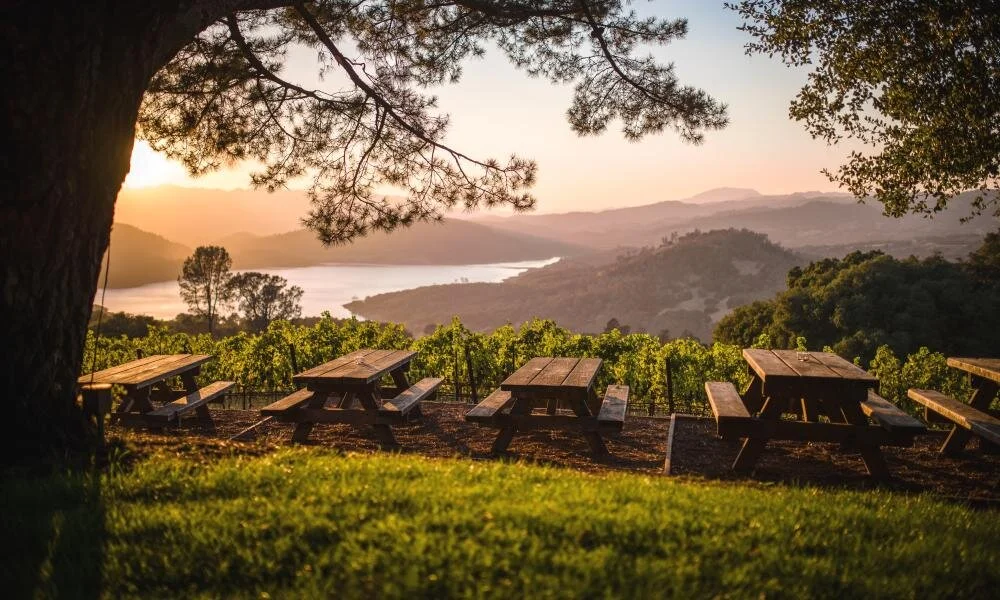Photo courtesy of Visit Napa Valley.
Beneath the lofty ceilings and high stone walls of Torc restaurant, a carnivorous hot spot in downtown Napa, California, chef Sean O’Toole approaches a dining room table with a metal grater. Shaving thick flecks of white Alba truffle over homemade tagliatelle with the finesse of one who’s spent years in the kitchen, the chef then trades truffle for pepper grinder while explaining the fine art of culinary indulgence—Napa-style.
“Nobody is asking for the steamed fish, all veggies, no oil… We just don’t get that health crowd here,” says chef O’Toole, who moved from San Francisco to cook in the valley, eventually taking over the vegetarian restaurant and yoga studio space that would become Torc. It’s only my first dinner in Napa (population 80,000), with its laid-back, chalet-town vibe, and it garners top marks before the second wine pairing comes out of Torc’s cellar. Here and across the valley, fulfillment and wellness go hand in hand.
Just shy of 50 kilometres long and eight kilometres wide, Napa Valley has over 400 wineries peppered in between its scenic, low knuckled hills. Its vineyards flush with the changing seasons—from a toasted wheat colour to deep mauve and fire-orange—and many wineries plant mustard or daisies to bloom in between the vines. Paul Giamatti may have soured the U.S. merlot industry when he swore (quite literally) off the grape in 2004’s wine flick, Sideways, but the rule here is try everything, and try often. The valley begs for multiple visits, so it’s best to prioritize Napa’s many indulgences with a checklist of stops. Besides, wine tastings have a knack of setting schedules off track on the best of days.
Waking up at the Inn on Randolph, a luxury bed and breakfast set within a renovated 19th-century mansion, gluten-free is on the menu—every morning. But there is nothing screaming health food about the plate set before me, which is a hash of roasted pork, purple potatoes, egg, grated carrot, and butternut squash sauce, paired with a glass of sparkling rosé. This is, after all, Napa.
“Those four letters, N–a–p–a, those alone are a brilliant marketing tool,” says Tom Walsh of Napa Valley Bike Tours as we ride among redwood trees and vineyards one cool afternoon in Yountville. On a bicycle the valley’s moods reveal themselves and, to a responsible degree, it’s the ideal way to stop and sip at wineries. “You can’t duplicate the back-road biking opportunities, or the smells of the eucalyptus and olive trees,” says Walsh.
This is also the terrain of Thomas Keller, the culinary patriarch of Napa Valley, who maintains his personal residence in Yountville and has put it on the gastronomic map with The French Laundry, as well as Bouchon Bistro, Bouchon Bakery (try the salted caramel macarons), Ad Hoc, the lunch spot Addendum, and a retail outlet, Finesse. In a town whose population hovers around 3,000, it has more Michelin stars per capita than any other wine region in the U.S.
Discreet Yountville is also home to one of only a handful of LEED platinum-certified hotels in the country: Bardessono. (When the property changed hands early this year, it ranked as one of the priciest transactions in California, selling for a cool $85-million). The green hotel is subtly built into its surroundings from local tufa stone and requires very little energy to run; there are 72 geothermal wells located under the parking lot, almost 1,000 solar panels on the rooftop, and all the vegetation is drought resistant.
Continuing on the wine trail, a little ways north in Oakville, is B Cellars. Wine pairing appetizers are prepared with cheeses, charcuterie, and garden-fresh produce—think zucchini and edible blossoms. Jim Borsack and Duffy Keys founded B Cellars in 2003, and winemaker Kirk Venge was brought on board for the first harvest later that year. The locale, previously a horse ranch, was purchased in 2012 and built up into its current idyllic setting complete with bee hives, a large garden, a chicken coop, and a wine cave, all set amidst cork trees and grapevines. (In 2014, the most recent stats, the value per ton of grapes harvested in Napa averaged some $4,000. Every 30 years or so grape production drops, and it makes economic sense to rip out the vines and start afresh.)
For a break from the requisite wine-trail stops, seek out solace of a different kind: Meadowood. The Relais & Châteaux property is, quite simply, the sparkling jewel in the valley’s crown. Driving up the eucalyptus-lined lane and ensconcing oneself by the 250-acre property’s outdoor pool, a sense of country-estate relaxation overwhelms. Founding partners H. William Harlan and E. Stanley Kroenke funnelled $60-million into the hotel in recent years, particularly after the Restaurant at Meadowood earned its third Michelin star, and this past November, opened the doors on a brand new spa.
The new Meadowood Spa was designed to mesh with nature, and one majestic, intertwined oak tree forms a centrepiece at its entrance.
“One of the most recommended things you can do for your well-being is to put technology away,” says Anni Hood, a global wellness consultant who assisted with customizing the spa programming at the Meadowood Spa. The rustic-luxe private suites look out onto lush vegetation and a relaxation garden offers post-treatment reprieve with a mineral soaking pool. Howard Backen designed the building to mesh with nature, and that’s most visible out into the inner courtyard where one majestic, intertwined oak tree forms an all-natural centrepiece at the spa entrance. The intention here is for all to disconnect—from technology, and from reality.
For an enigmatic finale dinner in the valley, I look no further than Harvest Table at the Harvest Inn by Charlie Palmer in nearby St. Helena. The celebrity chef opened the restaurant to push the envelope a little, while still remaining true to the spirit of Napa (Palmer employs a culinary horticulturist to tend to the greenery that ends up on the plates). Even the wine list is progressive for the valley. “Napa wine is great, but they drink it all day, every day,” says Palmer, who is in the kitchen this night. As such, the restaurant does blind wine tastings, where oenophile clientele try to guess the vintage, type, and origin of foil-covered bottles.
“The clientele is so diverse in Napa,” says Palmer. “They love their food, that’s why we can push it.” As the candles dim on the tables, Palmer checks in again, and before we know it he’s reminiscing about time spent cooking with legendary Julia Child. (“She was hilarious, and she loved me because we were the same height.”) Soon, Palmer is convincing the table to order the chocolate peanut butter bar for dessert—we’ve just had the whole-roasted truffle chicken, but why not—and tells us to come back for house-made Pop-Tarts, which feature pears picked from Palmer’s own trees.
Driving away from the restaurant, I roll down the window to catch the sweet aroma of grape production that characteristically fills the Napa air, here and there. Acres of vineyards flash by as the distant Vaca Mountains hold steady, awash in a falling light that seems to bathe them in merlot. There’s wine in those hills, for sure, but there’s also a whole lot more.

